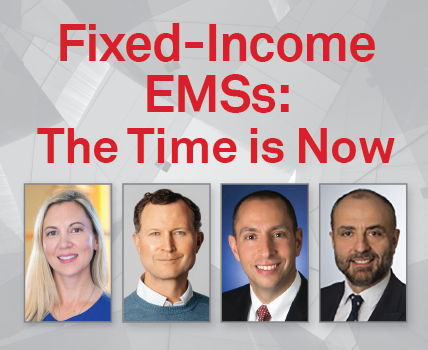Growing Awareness of Benefits of Fixed-Income EMSs to Spur Adoption
Fixed-income execution management systems (EMSs) offer benefits beyond enhancing workflow efficiencies and discovering liquidity, pointed out the panelists at a recent Coalition Greenwich webinar on Fixed-Income EMSs: The Time is Now moderated by Audrey Blater, Head of Risk & Regtech Research for the Market Structure & Technology group.
“An EMS is focused on the experience of traders in the market. I voted with my feet because I believed in it so much,” says Spencer Lee, who spent over two decades on the buy side before moving last year to EMS provider TS Imagine as Chief Markets Officer and Head of Fixed Income.
Indeed, a majority of participants in a recent Coalition Greenwich study of 41 buy-side firms with over $22 trillion in assets under management felt that an EMS gives them an edge in trading. However, only 39% use what they consider to be an EMS, and just 12% use one based on the current definition: a multi-venue, multi-data source technology.
How Can an EMS Help?
Traders today want access to liquidity from multiple venues and protocols, greater automation of trading workflows, and aggregation of data from multiple sources. An EMS can enable “all of these,” explains Spencer Lee: “Until now, it's been a very serial engagement. Buy-side traders go to individual venues for pre-trade price discovery. An EMS aggregates all that data and gives them the ability to execute on that liquidity through the same pipes.”
Access to liquidity on a single blotter and automating workflows are the most utilized EMS functions, as per the Coalition Greenwich study.
Engineering Demands
If the explosion of trading protocols is prompting traders to use more technology to manage risk transfer, it’s also placing new engineering demands on sell-side and trading venues.
Ken Ades, Senior Trading Strategist, US Credit E-Trading Strategist, Bank of America, says that while dealers want to be on all the platforms their clients choose—electronic trading, EMS, direct links—they consider factors such as “relationships, volumes and technology efforts,” since connecting to multiple channels is challenging.
“Dealers may have internal responder platforms that need to integrate and connect to each channel and speak to each of the different protocols,” he says. This entails wiring and configuring workflows, building code, quality assurance and governance scoring, as well as training traders. “Ultimately, we look for critical mass. We prioritize the builds based on client demand. So, it is a bit of chicken and egg when it pertains to client volumes and dealer adoption.”
Expanding the Horizons
These pain points exist on the buy side, too, but it’s also about “not knowing what’s possible,” observes Spencer Lee.
For instance, a big pain point for buy-side traders is the need to manually update multiple watch lists across venues so that they don’t miss a trading opportunity. An EMS blotter offers a one-spot “watch list for every venue.”
“You’ve got a much better chance when you’re using a platform that's looking across all venues simultaneously throughout the trading day. I remember beating everybody to it because my system woke me up to what was relevant for me,” he says.
Direct Connectivity
As the buy side seeks to provide more liquidity into the market, participants are also requesting more direct dealer connections. Spencer Lee believes the EMS is the “most-suited tech vendor” for this.
Adds Ken Ades, “The direct channel affords another way for dealers to match their axes to client needs. If we can do that, that's a win. It could also possibly lead to larger-size trades, which is where the market is looking to further electronify.”
Looking Ahead
Undoubtedly, EMS adoption is poised to grow. Progressive adopters are looking beyond existing functions. So, TS Imagine is using advanced technologies to create a “smart protocol chooser.”
Just as “a golfer doesn’t pull the same club for every shot,” EMS use will be “situational,” cautions Ken Ades. But as Spencer Lee notes, “Understanding of its utility is starting to spread across the marketplace.”

